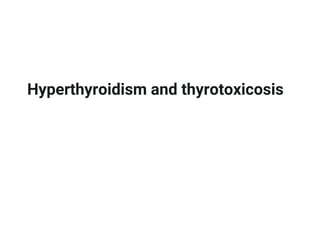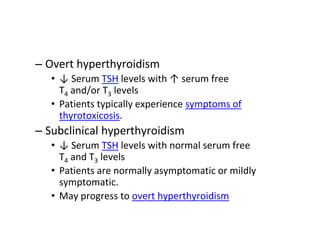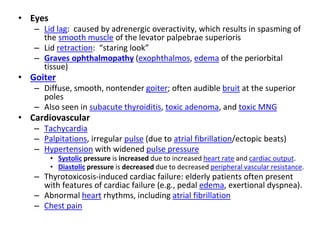Hyperthyroidism and thyrotoxicosis refer to excessive levels of circulating thyroid hormones. Hyperthyroidism is specifically caused by overproduction of thyroid hormones by the thyroid gland, which can lead to thyrotoxicosis. Common causes of hyperthyrotoxicosis include Graves' disease, toxic multinodular goiter, and toxic adenoma. Symptoms include fatigue, anxiety, heat intolerance, palpitations, and weight loss. Diagnosis involves thyroid hormone assays and tests to identify the underlying cause. Treatment begins with controlling symptoms using beta blockers, and may involve antithyroid drugs, radioactive iodine ablation, or surgery to definitively treat the condition.



![https://youtu.be/b2DtAALZj7o
• While thyrotoxicosis and hyperthyroidism are
often used interchangeably, the two terms are
not synonymous. [1]
• Thyrotoxicosis: a hypermetabolic condition
caused by an inappropriately high level of
circulating thyroid hormones irrespective of the
source.
• Hyperthyroidism: a condition characterized by
the overproduction of thyroid hormones by
the thyroid gland; can cause thyrotoxicosis](https://image.slidesharecdn.com/hyperthyroidismandthyrotoxicosis-221012014603-ef7ac8af/85/Hyperthyroidism-and-thyrotoxicosis-pptx-4-320.jpg)

![• Prevalence [9]
– Overt hyperthyroidism: ∼ 1%
– Subclinical hyperthyroidism: 2–3%
• Sex: ♀ > ♂ (5:1)
• Age range at presentation [10]
– Graves disease: 20–30 years of age
– Toxic adenoma: 30–50 years of age
– Toxic MNG: peak incidence > 50 years of age](https://image.slidesharecdn.com/hyperthyroidismandthyrotoxicosis-221012014603-ef7ac8af/85/Hyperthyroidism-and-thyrotoxicosis-pptx-6-320.jpg)



![• Effects of thyrotoxicosis
• Generalized hypermetabolism (increased substrate
consumption)
– ↑ Number of Na+/K+-ATPase → elevation of
basal metabolism → promoted thermogenesis
– Upregulation of β-adrenergic receptors →
hyperstimulation of the sympathetic nervous system
• Cardiac effects → ↑ cardiac output [15]
– ↑ Numbers of ATPase on cardiac myocytes; ↓ amount
of phospholamban (PLB) → ↑
transsarcolemmal Ca2+ movement → enhanced myocardial
contractility
– ↓ Peripheral vascular resistance](https://image.slidesharecdn.com/hyperthyroidismandthyrotoxicosis-221012014603-ef7ac8af/85/Hyperthyroidism-and-thyrotoxicosis-pptx-10-320.jpg)


![• Musculoskeletal
– Fine tremor of the outstretched fingers
– Hyperthyroid myopathy
• Predominantly affects individuals > 40 years of age
• Proximal muscles are predominantly affected
• Serum creatine kinase levels are most often normal
– Osteopathy: osteoporosis due to the direct effect of T3 on osteoclastic bone
resorption , fractures (in the elderly)
• Endocrinological
– Female: oligo/amenorrhoea, anovulatory infertility, dysfunctional uterine
bleeding
– Male: gynecomastia, decreased libido, infertility, erectile dysfunction
– Glucose intolerance [16]
• ↓ Insulin sensitivity of peripheral tissue
• Impaired insulin secretion
• Neuropsychiatric system
– Anxiety
– Emotional instability
– Depression
– Restlessness
– Insomnia
– Tremoulousness (results from the hyperadrenergic state)
– Hyperreflexia](https://image.slidesharecdn.com/hyperthyroidismandthyrotoxicosis-221012014603-ef7ac8af/85/Hyperthyroidism-and-thyrotoxicosis-pptx-13-320.jpg)


![• Subsequent evaluation
• Indicated if the diagnosis remains uncertain after
clinical assessment and initial evaluation. The choice
and priority of studies depends on the clinical picture,
patient characteristics and test availability.
• TSH receptor antibody (TRAb)
• Indication: if Graves disease is suspected but classic
clinical features are absent [17]
• Interpretation
– Positive: Diagnosis of Graves disease is established.
– Negative: Further investigation is necessary.](https://image.slidesharecdn.com/hyperthyroidismandthyrotoxicosis-221012014603-ef7ac8af/85/Hyperthyroidism-and-thyrotoxicosis-pptx-16-320.jpg)
![• Nuclear medicine thyroid scan and radioactive iodine uptake
measurement [19]
• Definitions
– Nuclear medicine thyroid scan: a nuclear medicine imaging technique that
visualizes the distribution of thyroid function using an oral or IV radiotracer
(most commonly Tc-99m pertechnetate or iodine-123)
– Radioactive iodine uptake measurement (RAIU test): a test that quantifies the
percentage of the administered amount of radioactive iodine taken up by
the thyroid gland [20]
• Indications [17]
– First-line test for most patients with uncertain etiology of thyrotoxicosis after
initial evaluation
– Assessment of functional status of thyroid nodules [20]
– Thyroid malignancy (see “Diagnostics" in “Thyroid cancer”)
– Identification of ectopic thyroid tissue (e.g., lingual thyroid, struma ovarii)
– Evaluation of retrosternal goiters
– Evaluation of thyroglossal cysts](https://image.slidesharecdn.com/hyperthyroidismandthyrotoxicosis-221012014603-ef7ac8af/85/Hyperthyroidism-and-thyrotoxicosis-pptx-17-320.jpg)
![• Contraindications: pregnant
or breastfeeding women [17]
• Findings
– Hot nodule: Hyperfunctioning tissue takes up large
amounts of radioactive iodine
– Cold nodule: Non-functioning nodules do not take up
any radioactive iodine and appear "cold”, but the
surrounding normal thyroid tissue takes
up radioactive iodine and appears "warm"
– See also “Diagnostics” in “Thyroid cancer” and
“Diagnostic steps for thyroid nodules”](https://image.slidesharecdn.com/hyperthyroidismandthyrotoxicosis-221012014603-ef7ac8af/85/Hyperthyroidism-and-thyrotoxicosis-pptx-18-320.jpg)
![• Thyroid ultrasound with Doppler
• Indications [21]
– Palpable abnormality, e.g., goiter or nodules
– Additional study following nuclear medicine thyroid scan or second-
line initial imaging study
– Preferred imaging technique in pregnant or breastfeeding women
• Typical findings [21]
– Changes to morphology: diffuse enlargement or nodules
– Increased perfusion: either diffuse (Graves disease, toxic adenoma) or
nodular (toxic MNG)
– Decreased perfusion: destructive causes
of hyperthyroidism (e.g., subacute thyroiditis or postpartum
destructive thyroiditis)
– Hypoechoic areas in acute thyroiditis and malignancy](https://image.slidesharecdn.com/hyperthyroidismandthyrotoxicosis-221012014603-ef7ac8af/85/Hyperthyroidism-and-thyrotoxicosis-pptx-19-320.jpg)

![• Other thyroid antibodies [17]
– Thyroid peroxidase antibodies (TPOAb)
• Indication: suspected subacute lymphocytic thyroiditis,
including postpartum thyroiditis
• Elevated levels may also be seen in Graves disease.
– Thyroglobulin antibodies (TgAb): not routinely indicated
but can be elevated in Graves disease, autoimmune
conditions, and thyroid cancer
– See also “Thyroid antibodies.”
• Serum thyroglobulin (Tg): indicated for
suspected exogenous hyperthyroidism with unclear
history
– Serum Tg should be assessed alongside TgAb because
a TgAb-positive result indicates an
unreliable serum Tg finding. [17]
– Findings
• Exogenous hyperthyroidism: ↓ Tg due to production that is
suppressed by the administered thyroid hormones
• Endogenous hyperthyroidism: normal or ↑ Tg](https://image.slidesharecdn.com/hyperthyroidismandthyrotoxicosis-221012014603-ef7ac8af/85/Hyperthyroidism-and-thyrotoxicosis-pptx-21-320.jpg)

![• Symptomatic therapy for thyrotoxicosis [17]
• The treatment of hyperadrenergic symptoms is
important for decreasing the risk of cardiac
complications in thyrotoxicosis, such as atrial
fibrillation and heart failure.
• Indication: all symptomatic patients
• Treatment of hyperadrenergic symptoms: beta
blockers (first line)
– Provide immediate control of symptoms, e.g.,
neuropsychiatric and/or hyperadrenergic symptoms
– Treatment options
• First line: propranolol
• Alternatives: atenolol OR metoprolol
• Severe thyrotoxicosis or thyroid storm treated in ICU: esmolol
– If there are contraindications to beta blockers, e.g.,
severe asthma, Raynaud phenomenon ,
consider CCBs: verapamil OR diltiazem . [22]](https://image.slidesharecdn.com/hyperthyroidismandthyrotoxicosis-221012014603-ef7ac8af/85/Hyperthyroidism-and-thyrotoxicosis-pptx-23-320.jpg)
![• Definitive therapy for hyperthyroidism and thyrotoxicosis [17][23]
• The choice of therapy depends on the individual clinical situation and patient
preference.
• There are three effective initial treatment options for Graves disease: antithyroid
drugs, RAIA, and surgery
• RAIA or surgery is preferable to antithyroid drugs for toxic MNG and toxic adenoma.
• Antithyroid drugs for thyrotoxicosis
• Antithyroid drugs can effectively render a patient euthyroid. 20–75% of patients
with Graves disease achieve permanent remission after 1–2 years of treatment;
however, some patient groups have a higher likelihood of remission than others.
• Indications
– Thyroid storm: initial management as well as prevention in at-risk patients prior to surgery
or RAIA
– Graves disease: Patients with high remission likelihood , and/or moderate to severe active Graves
ophthalmopathy
– Contraindications to both RAIA and surgery
– Other: hyperthyroidism in pregnancy, limited life expectancy, patient preference
• Medication
– The choice of medication depends on the severity of symptoms and patient factors.
• Most patients: methimazole
• Thyroid storm or first trimester of pregnancy: propylthiouracil
– See also “Adverse effects” in “Antithyroid drugs”.](https://image.slidesharecdn.com/hyperthyroidismandthyrotoxicosis-221012014603-ef7ac8af/85/Hyperthyroidism-and-thyrotoxicosis-pptx-24-320.jpg)
![• Radioactive iodine ablation (RAIA) [26]
• Definition: destruction of thyroid tissue via radioactive
iodine (iodine-131) through a sodium/iodine symporter
• Technical background: Radioactive iodine-131 emits both gamma
and beta rays.
– Gamma rays: diagnostic effect
– Beta rays: therapeutic effect
• Indications
– Toxic MNG and toxic adenoma with high nodular radioactive iodine
uptake
– Failure to achieve euthyroidism with antithyroid drugs (ATDs) in Graves
disease, due to:
• Refractory disease
• Contraindications to ATDs, e.g., liver disease
• Major adverse reactions to ATDs
– High surgical risk due to comorbidities or previous surgery or
radiation of the neck
– Limited life-expectancy
– Other: thyrotoxic periodic paralysis](https://image.slidesharecdn.com/hyperthyroidismandthyrotoxicosis-221012014603-ef7ac8af/85/Hyperthyroidism-and-thyrotoxicosis-pptx-25-320.jpg)

![• Procedure: Single oral dose of iodine-131 →
isotope uptake by thyroid gland → emission of beta
radiation that slowly destroys the thyroid tissue
• Complications [28][29]
– Early
• Most patients with Graves disease become hypothyroid
after RAIA and require life-long thyroid hormone replacement
• Gastritis: nausea and vomiting
• Sialadenitis
• Other: transient loss of taste or smell, stomatitis, transient bone
marrow suppression
– Late
• Radiation-induced thyroiditis
• Secondary malignancy or leukemia
• Dry mouth (xerostomia)](https://image.slidesharecdn.com/hyperthyroidismandthyrotoxicosis-221012014603-ef7ac8af/85/Hyperthyroidism-and-thyrotoxicosis-pptx-27-320.jpg)
![• Thyroid surgery [30]
• The efficacy of antithyroid drugs and RAIA has reduced the need
for thyroid surgery.
• Indications
– Large goiters (≥ 80 g) or obstructive symptoms
– Confirmed or suspected thyroid malignancy
– Graves disease with: [31]
• Concomitant primary hyperparathyroidism or periodic paralysis
• Moderate to severe active Graves ophthalmopathy [24]
– Toxic MNG or toxic adenoma with: concomitant primary hyperparathyroidism,
insufficient RAIA, or retrosternal extension
– Other: large thyroid nodules , refractory amiodarone-induced thyrotoxicosis ,
planned pregnancy within next 6 months , or patient preference
•](https://image.slidesharecdn.com/hyperthyroidismandthyrotoxicosis-221012014603-ef7ac8af/85/Hyperthyroidism-and-thyrotoxicosis-pptx-28-320.jpg)







![• Definition [17]
• An acute exacerbation of hyperthyroidism that results in a life-
threatening hypermetabolic state.
• Also known as thyrotoxic crisis
• Etiology [17]
• Iatrogenic
– Thyroid surgery
– RAIA
– Exogenous iodine from contrast media or amiodarone
– Discontinuation of antithyroid medication
• Stress-related catecholamine surge
– Nonthyroidal surgery
– Anesthesia induction
– Labor
– Intercurrent illness, e.g., sepsis, myocardial infarction, diabetic ketoacidosis](https://image.slidesharecdn.com/hyperthyroidismandthyrotoxicosis-221012014603-ef7ac8af/85/Hyperthyroidism-and-thyrotoxicosis-pptx-36-320.jpg)
![• Clinical features [17]
• Hyperpyrexia with profuse sweating
• Tachycardia (> 140/minute) and (possibly
severe) arrhythmia (e.g., atrial fibrillation), hypertension with
wide pulse pressure, congestive cardiac failure
• Hypotension/shock secondary to high output heart
failure or hypovolemia as a result of GI and insensible losses
• Symptoms of thyrotoxicosis
• Abdominal pain
• Severe nausea, vomiting, diarrhea, possibly jaundice
• Severe agitation and anxiety, delirium and psychoses, seizures, com
a](https://image.slidesharecdn.com/hyperthyroidismandthyrotoxicosis-221012014603-ef7ac8af/85/Hyperthyroidism-and-thyrotoxicosis-pptx-37-320.jpg)
![• Diagnostics [17]
• A thyroid storm is diagnosed on the basis of classic clinical features and
supporting TFT abnormalities, e.g., low/undetectable TSH, elevated free T3/T4.
• Further tests should be performed to identify any underlying precipitants and to assess for
complications, e.g.:
– ECG to assess for atrial fibrillation
– Liver chemistries to assess for evidence of jaundice
• Treatment of thyroid storm [17][36]
• Thyroid storm has a high mortality rate and patients should receive aggressive treatment to
manage complications and restore normal thyroid function.
• Approach
• Consult critical care for ICU admission and monitoring.
• Start symptomatic treatment to manage hypotension, hyperpyrexia, and tachycardia.
• Administer medication to reduce thyroid hormone synthesis and release, and inhibit their
peripheral action.
• Identify and treat any precipitating cause.
• Once the patient is stable, initiate definitive therapy for hyperthyroidism and thyrotoxicosis.
• Consider plasmapheresis or emergency surgery as life-saving treatment for rare refractory cases](https://image.slidesharecdn.com/hyperthyroidismandthyrotoxicosis-221012014603-ef7ac8af/85/Hyperthyroidism-and-thyrotoxicosis-pptx-38-320.jpg)
![• Symptomatic treatment
• Hyperadrenergic symptoms: beta blockers are first-line
– Preferred: Propranolol, due to combined beta-blockade and
antithyroid effects
– Alternatives
• Preexisting heart failure: esmolol [18][37]
• Mild obstructive airway disease/stable asthma: atenolol or metoprolol
– Beta blocker contraindications: consider CCBs, e.g., diltiazem
• Hyperthermia
– External cooling techniques (e.g., ice packs, cooling blankets, alcohol
washes)
– Antipyretics, e.g., acetaminophen
• Hypotension and hypovolemia: fluid resuscitation to treat
insensible and GI losses [36]
• Electrolyte disturbances: (see “Electrolyte repletion”)](https://image.slidesharecdn.com/hyperthyroidismandthyrotoxicosis-221012014603-ef7ac8af/85/Hyperthyroidism-and-thyrotoxicosis-pptx-39-320.jpg)
![• Antithyroid drugs in thyroid storm [17][18][22]
• Inhibition of thyroid hormone synthesis
– First line: propylthiouracil
– Alternative: methimazole
• Inhibition of thyroid hormone release (through the Wolff-Chaikoff effect)
– First line: iodine solutions given at least 1 hour after antithyroid drugs
• Potassium iodide solution
• Lugol solution
– In patients with iodine allergy or iodine-induced thyrotoxicosis, lithium can be
used.
• Inhibition of peripheral conversion of T4 to T3
– Propranolol
– Glucocorticoids: can also treat concurrent adrenal insufficiency
• First line: hydrocortisone
• Alternative: dexamethasone](https://image.slidesharecdn.com/hyperthyroidismandthyrotoxicosis-221012014603-ef7ac8af/85/Hyperthyroidism-and-thyrotoxicosis-pptx-40-320.jpg)

